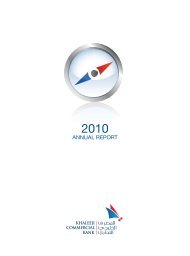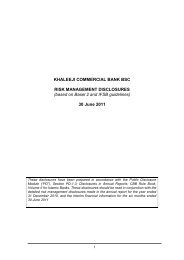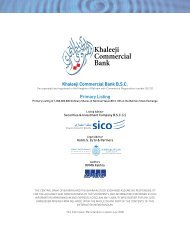2011 Annual Report - Khaleeji Commercial Bank BSC
2011 Annual Report - Khaleeji Commercial Bank BSC
2011 Annual Report - Khaleeji Commercial Bank BSC
Create successful ePaper yourself
Turn your PDF publications into a flip-book with our unique Google optimized e-Paper software.
KHALEEJI COMMERCIAL BANK <strong>BSC</strong><br />
NOTES TO THE CONSOLIDATED FINANCIAL STATEMENTS<br />
for the year ended 31 December <strong>2011</strong><br />
31. RISK MANAGEMENT (continued)<br />
Settlement risk<br />
The <strong>Bank</strong>’s activities may give rise to risk at the time of settlement of transactions and trades. Settlement risk is the risk of loss<br />
due to the failure of a company to honour its obligations to deliver cash, securities or other assets as contractually agreed.<br />
Settlement limits form part of the credit approval / limit monitoring process described earlier. Acceptance of settlement risk<br />
on free settlement trades requires transaction specific or counterparty specific approvals from RMD.<br />
Liquidity Risk<br />
Liquidity risk is the risk that the <strong>Bank</strong> will encounter difficulty in meeting obligations associated with its financial liabilities that<br />
are settled by delivering cash or another financial assets.<br />
Management of liquidity risk<br />
The <strong>Bank</strong>’s approach to managing liquidity is to ensure, as far as possible, that it will always have sufficient liquidity to meet its<br />
liabilities when due, under both normal and stressed conditions, without incurring unacceptable losses or risking damage to<br />
the <strong>Bank</strong>’s reputation.<br />
Financial Control Department (FCD) collates data from treasury and other business units regarding the liquidity profile of their<br />
financial assets and liabilities and details of other projected cash flows arising from projected future business. FCD communicates<br />
the information to the treasury who manages the <strong>Bank</strong>’s portfolio of short-term liquid assets, largely made up of short-term<br />
placements with other banks and other inter-bank facilities, to ensure that sufficient liquidity is maintained within the <strong>Bank</strong> as a<br />
whole.<br />
The daily liquidity position is monitored by FCD. The <strong>Bank</strong> has in place a Liquidity Contingency Plan, the elements of which are<br />
periodically tested. Tools for implementation of regular stress testing under various scenarios are in place. All liquidity policies<br />
and procedures are subject to review by ALCO and approval by appropriate authorities. A summary report, including any<br />
exceptions and remedial action taken, is submitted regularly to ALCO members.<br />
Exposure to liquidity risk<br />
The key measure used by the <strong>Bank</strong> for managing liquidity risk is the ratio of net liquid assets to deposits from customers.<br />
For computation of this, net liquid assets are considered as including cash and bank balances and placements with financial<br />
Institutions less placements from financial institution, and deposits comprise current accounts, placements from non-financial<br />
institutions and individuals, and equity of investment account holders.<br />
Details of the reported <strong>Bank</strong> ratio of net liquid assets to deposits and customers at the reporting date and during the reporting<br />
period were as follows:<br />
<strong>2011</strong> 2010<br />
% %<br />
At 31 December 23.21 10.52<br />
Average for the period 11.68 15.79<br />
Maximum for the period 23.21 19.44<br />
Minimum for the period 6.54 10.52<br />
For maturity profile of assets and liabilities refer to note 28.<br />
Market Risk<br />
Market risk is the risk that changes in market prices, such as profit rate, equity prices, foreign exchange rates and credit spreads<br />
will affect the <strong>Bank</strong>’s income, future cash flows or the value of its holdings of financial instruments. Market risk comprises three<br />
types of risk: currency risk, profit rate risk and other price risk. The objective of market risk management is to manage and<br />
control market risk exposures within acceptable parameters, while optimising the return on risk.<br />
Consolidated Financial Statements<br />
73










